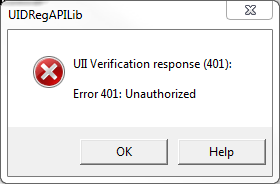 MIL-Comply issues several variations of this error, beginning with UII Verification response (nnn) where nnn can be one of several error codes.
MIL-Comply issues several variations of this error, beginning with UII Verification response (nnn) where nnn can be one of several error codes.
What happened: An error occurred attempting to communicate with the IUID Registry to confirm the existence of one or more UIDs. This may occur when:
•Adding UID items to a shipment
•Printing UID Part Mark labels
•Looking up UID(s) in the IUID Registry
•Attempting to take custody of GFP Items for Maintenance Repair or Overhaul
UII Verification generally occurs automatically when performing one of the tasks listed above, but only when a WAWF Password has been added to the WAWF User Setup. Removing it will eliminate the error by stopping Registry queries. Correcting the problem depends on the error number:
IMPORTANT: IUID Registry Verification is a convenience, but not required for WAWF or GFP transactions. If errors persist, disable it by deleting your WAWF User Password. |
Error Numbers
401 - Unauthorized Access. This can occur if:
oYour WAWF User Password is incorrect or expired.
oYour WAWF User ID is incorrect or expired.
oThe User ID has not been granted sufficient rights (General Purpose API role) by your WAWF Group Administrator (GAM).
oTest Mode is enabled in the WAWF User Setup, which causes MIL-Comply to query the Test Registry instead of the production one. Use of Test Mode requires coordination with Mil-Pac and the WAWF (PIEE) Help Desk, and is rarely required by individual contractors.
403 - Forbidden. This is generally caused by your firewall preventing the web services (HTTPS/TLS 1.2) query to go through.
404 - URL Not Found. The IUID Registry web service endpoint is temporarily unavailable or has moved without being forwarded (via a 301 response).
408 - Request Timeout. There are problems with the IUID Registry / PIEE servers causing processing delays. Try again at another time or contact the PIEE Help Desk.
500 - Unknown Error. The IUID Registry web services server is temporarily broken. Try again at another time or contact the PIEE Help Desk.
503 - Server Capacity Reached. The IUID Registry web services server is unable to keep up with demand. Try again at another time or contact the PIEE Help Desk.

Communications Setup Error
HTTP Result [nn]. An underlying error occurred during HTTPS communication with the IUID Registry. Try again, wait a while if possible. Restarting MIL-Comply or your PC may help, but the problem is likely transient situation outside of those two systems.
0 - Unspecified Error - usually follows an HTTP Result error, indicating that no communications occurred.
IUID Registry Verification occurs directly between your PC and the PIEE server. The Mil-Pac VAN is not involved, nor does Mil-Pac have any direct visibility of the PIEE servers, your network or firewall, or your connection to PIEE. Therefore we are unlikely to be able to assist, other than to refer issues to the IUID Registry Help Desk and/or PIEE Help Desk. A notable exception is the following error:
418 - I'm a Teapot. Seriously, this is an officially sanctioned HTTP response code that MIL-Comply issues when in IUID Registry Emulation Mode the operator responds to a UID verification request with an error, allowing the user to observe the software's error handling. Code 418 is used for this purpose because it is in the correct range but cannot be mistaken for an actual error condition. Users interested in using Registry Emulation should request documentation from Mil-Pac Technical Support.
I'm A Teapot (HTTP Error 418) This HTTP response code "was defined in 1998 as one of the traditional IETF [Internet Engineering Task Force] April Fools' jokes, in RFC 2324, (the) Hyper Text Coffee Pot Control Protocol, and is not expected to be implemented by actual HTTP servers. The RFC specifies this code should be returned by teapots requested to brew coffee. This HTTP status is used as an Easter egg in some websites, such as Google.com's I'm a teapot Easter egg." Wikipedia |